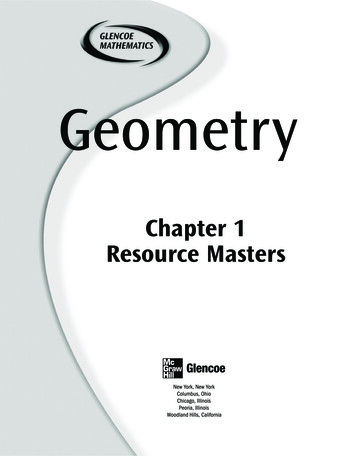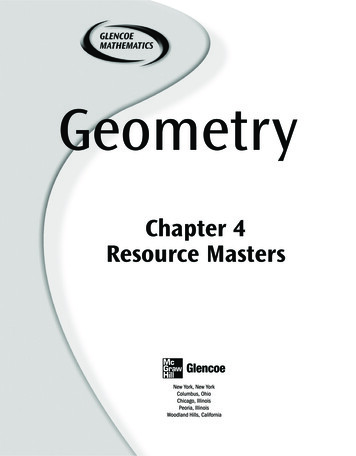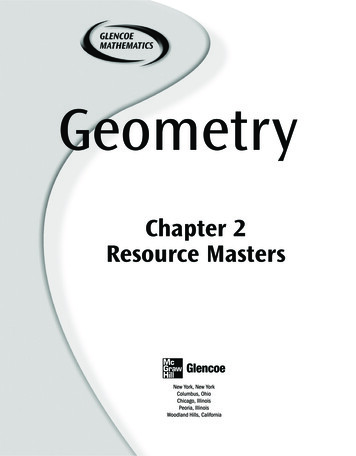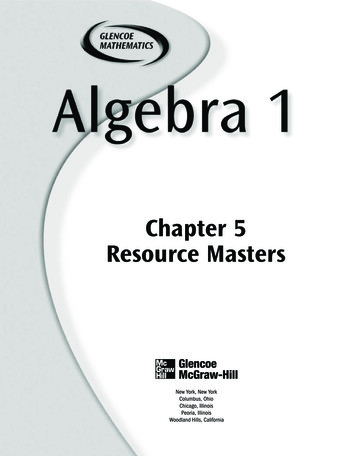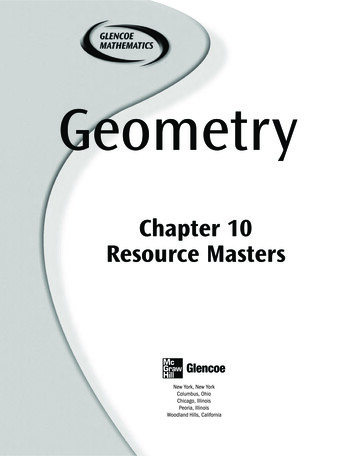
Transcription
GeometryChapter 10Resource Masters
Consumable WorkbooksMany of the worksheets contained in the Chapter Resource Masters bookletsare available as consumable workbooks.Study Guide and Intervention WorkbookSkills Practice WorkbookPractice WorkbookReading to Learn Mathematics 7-861061-3ANSWERS FOR WORKBOOKS The answers for Chapter 10 of these workbookscan be found in the back of this Chapter Resource Masters booklet.Copyright by The McGraw-Hill Companies, Inc. All rights reserved.Printed in the United States of America. Permission is granted to reproduce thematerial contained herein on the condition that such material be reproduced onlyfor classroom use; be provided to students, teachers, and families without charge;and be used solely in conjunction with Glencoe’s Geometry. Any other reproduction,for use or sale, is prohibited without prior written permission of the publisher.Send all inquiries to:The McGraw-Hill Companies8787 Orion PlaceColumbus, OH 43240-4027ISBN: 0-07-860187-81 2 3 4 5 6 7 8 9 10 009 11 10 09 08 07 06 05 04 03GeometryChapter 10 Resource Masters
ContentsVocabulary Builder . . . . . . . . . . . . . . . . viiLesson 10-6Proof Builder . . . . . . . . . . . . . . . . . . . . . . ixStudy Guide and Intervention . . . . . . . . 571–572Skills Practice . . . . . . . . . . . . . . . . . . . . . . . 573Practice . . . . . . . . . . . . . . . . . . . . . . . . . . . 574Reading to Learn Mathematics . . . . . . . . . . 575Enrichment . . . . . . . . . . . . . . . . . . . . . . . . . 576Lesson 10-1Study Guide and Intervention . . . . . . . . 541–542Skills Practice . . . . . . . . . . . . . . . . . . . . . . . 543Practice . . . . . . . . . . . . . . . . . . . . . . . . . . . 544Reading to Learn Mathematics . . . . . . . . . . 545Enrichment . . . . . . . . . . . . . . . . . . . . . . . . . 546Lesson 10-7Study Guide and Intervention . . . . . . . . 577–578Skills Practice . . . . . . . . . . . . . . . . . . . . . . . 579Practice . . . . . . . . . . . . . . . . . . . . . . . . . . . 580Reading to Learn Mathematics . . . . . . . . . . 581Enrichment . . . . . . . . . . . . . . . . . . . . . . . . . 582Lesson 10-2Study Guide and Intervention . . . . . . . . 547–548Skills Practice . . . . . . . . . . . . . . . . . . . . . . . 549Practice . . . . . . . . . . . . . . . . . . . . . . . . . . . 550Reading to Learn Mathematics . . . . . . . . . . 551Enrichment . . . . . . . . . . . . . . . . . . . . . . . . . 552Lesson 10-8Study Guide and Intervention . . . . . . . . 583–584Skills Practice . . . . . . . . . . . . . . . . . . . . . . . 585Practice . . . . . . . . . . . . . . . . . . . . . . . . . . . 586Reading to Learn Mathematics . . . . . . . . . . 587Enrichment . . . . . . . . . . . . . . . . . . . . . . . . . 588Lesson 10-3Study Guide and Intervention . . . . . . . . 553–554Skills Practice . . . . . . . . . . . . . . . . . . . . . . . 555Practice . . . . . . . . . . . . . . . . . . . . . . . . . . . 556Reading to Learn Mathematics . . . . . . . . . . 557Enrichment . . . . . . . . . . . . . . . . . . . . . . . . . 558Chapter 10 AssessmentChapter 10 Test, Form 1 . . . . . . . . . . . 589–590Chapter 10 Test, Form 2A . . . . . . . . . . 591–592Chapter 10 Test, Form 2B . . . . . . . . . . 593–594Chapter 10 Test, Form 2C . . . . . . . . . . 595–596Chapter 10 Test, Form 2D . . . . . . . . . . 597–598Chapter 10 Test, Form 3 . . . . . . . . . . . 599–600Chapter 10 Open-Ended Assessment . . . . . 601Chapter 10 Vocabulary Test/Review . . . . . . 602Chapter 10 Quizzes 1 & 2 . . . . . . . . . . . . . . 603Chapter 10 Quizzes 3 & 4 . . . . . . . . . . . . . . 604Chapter 10 Mid-Chapter Test . . . . . . . . . . . . 605Chapter 10 Cumulative Review . . . . . . . . . . 606Chapter 10 Standardized Test Practice 607–608Unit 3 Test/Review (Ch. 8–10) . . . . . . . 609–610Lesson 10-4Study Guide and Intervention . . . . . . . . 559–560Skills Practice . . . . . . . . . . . . . . . . . . . . . . . 561Practice . . . . . . . . . . . . . . . . . . . . . . . . . . . 562Reading to Learn Mathematics . . . . . . . . . . 563Enrichment . . . . . . . . . . . . . . . . . . . . . . . . . 564Lesson 10-5Study Guide and Intervention . . . . . . . . 565–566Skills Practice . . . . . . . . . . . . . . . . . . . . . . . 567Practice . . . . . . . . . . . . . . . . . . . . . . . . . . . 568Reading to Learn Mathematics . . . . . . . . . . 569Enrichment . . . . . . . . . . . . . . . . . . . . . . . . . 570Standardized Test PracticeStudent Recording Sheet . . . . . . . . . . . . . . A1ANSWERS . . . . . . . . . . . . . . . . . . . . . . A2–A36 Glencoe/McGraw-HilliiiGlencoe Geometry
Teacher’s Guide to Using theChapter 10 Resource MastersThe Fast File Chapter Resource system allows you to conveniently file the resourcesyou use most often. The Chapter 10 Resource Masters includes the core materialsneeded for Chapter 10. These materials include worksheets, extensions, andassessment options. The answers for these pages appear at the back of this booklet.All of the materials found in this booklet are included for viewing and printing in theGeometry TeacherWorks CD-ROM.Vocabulary Builder Pages vii–viiiinclude a student study tool that presentsup to twenty of the key vocabulary termsfrom the chapter. Students are to recorddefinitions and/or examples for each term.You may suggest that students highlight orstar the terms with which they are notfamiliar.Skills PracticeWHEN TO USE Give these pages tostudents before beginning Lesson 10-1.Encourage them to add these pages to theirGeometry Study Notebook. Remind them toadd definitions and examples as theycomplete each lesson.PracticeThere is one master foreach lesson. These provide computationalpractice at a basic level.WHEN TO USE These masters can beused with students who have weakermathematics backgrounds or needadditional reinforcement.There is one master for eachlesson. These problems more closely followthe structure of the Practice and Applysection of the Student Edition exercises.These exercises are of average difficulty.WHEN TO USE These provide additionalpractice options or may be used ashomework for second day teaching of thelesson.Vocabulary Builder Pages ix–xinclude another student study tool thatpresents up to fourteen of the key theoremsand postulates from the chapter. Studentsare to write each theorem or postulate intheir own words, including illustrations ifthey choose to do so. You may suggest thatstudents highlight or star the theorems orpostulates with which they are not familiar.Reading to Learn MathematicsOne master is included for each lesson. Thefirst section of each master asks questionsabout the opening paragraph of the lessonin the Student Edition. Additionalquestions ask students to interpret thecontext of and relationships among termsin the lesson. Finally, students are asked tosummarize what they have learned usingvarious representation techniques.WHEN TO USE Give these pages tostudents before beginning Lesson 10-1.Encourage them to add these pages to theirGeometry Study Notebook. Remind them toupdate it as they complete each lesson.WHEN TO USE This master can be usedas a study tool when presenting the lessonor as an informal reading assessment afterpresenting the lesson. It is also a helpfultool for ELL (English Language Learner)students.Study Guide and InterventionEach lesson in Geometry addresses twoobjectives. There is one Study Guide andIntervention master for each objective.WHEN TO USE Use these masters asreteaching activities for students who needadditional reinforcement. These pages canalso be used in conjunction with the StudentEdition as an instructional tool for studentswho have been absent. Glencoe/McGraw-HillivGlencoe Geometry
A Vocabulary Test, suitable for allstudents, includes a list of the vocabularywords in the chapter and ten questionsassessing students’ knowledge of thoseterms. This can also be used in conjunction with one of the chapter tests or as areview worksheet.EnrichmentThere is one extensionmaster for each lesson. These activities mayextend the concepts in the lesson, offer anhistorical or multicultural look at theconcepts, or widen students’ perspectives onthe mathematics they are learning. Theseare not written exclusively for honorsstudents, but are accessible for use with alllevels of students.Intermediate Assessment Four free-response quizzes are includedto offer assessment at appropriateintervals in the chapter.WHEN TO USE These may be used asextra credit, short-term projects, or asactivities for days when class periods areshortened. A Mid-Chapter Test provides an optionto assess the first half of the chapter. It iscomposed of both multiple-choice andfree-response questions.Assessment OptionsThe assessment masters in the Chapter 10Resources Masters offer a wide range ofassessment tools for intermediate and finalassessment. The following lists describe eachassessment master and its intended use.Continuing Assessment The Cumulative Review providesstudents an opportunity to reinforce andretain skills as they proceed throughtheir study of Geometry. It can also beused as a test. This master includesfree-response questions.Chapter AssessmentCHAPTER TESTS The Standardized Test Practice offerscontinuing review of geometry conceptsin various formats, which may appear onthe standardized tests that they mayencounter. This practice includes multiplechoice, grid-in, and short-responsequestions. Bubble-in and grid-in answersections are provided on the master. Form 1 contains multiple-choice questionsand is intended for use with basic levelstudents. Forms 2A and 2B contain multiple-choicequestions aimed at the average levelstudent. These tests are similar in formatto offer comparable testing situations. Forms 2C and 2D are composed of freeresponse questions aimed at the averagelevel student. These tests are similar informat to offer comparable testingsituations. Grids with axes are providedfor questions assessing graphing skills.Answers Page A1 is an answer sheet for theStandardized Test Practice questionsthat appear in the Student Edition onpages 588–589. This improves students’familiarity with the answer formats theymay encounter in test taking. Form 3 is an advanced level test withfree-response questions. Grids withoutaxes are provided for questions assessinggraphing skills. The answers for the lesson-by-lessonmasters are provided as reduced pageswith answers appearing in red.All of the above tests include a freeresponse Bonus question. Full-size answer keys are provided forthe assessment masters in this booklet. The Open-Ended Assessment includesperformance assessment tasks that aresuitable for all students. A scoring rubricis included for evaluation guidelines.Sample answers are provided forassessment. Glencoe/McGraw-HillvGlencoe Geometry
NAME DATEPERIODReading to Learn Mathematics10This is an alphabetical list of the key vocabulary terms you will learn inChapter 10. As you study the chapter, complete each term’s definition or description.Remember to add the page number where you found the term. Add these pages toyour Geometry Study Notebook to review vocabulary at the end of the chapter.Vocabulary TermFoundon PageDefinition/Description/Examplecentercentral inscribed(continued on the next page) Glencoe/McGraw-HillviiGlencoe GeometryVocabulary BuilderVocabulary Builder
NAME DATEPERIODReading to Learn Mathematics10Vocabulary BuilderVocabulary Term(continued)Foundon PageDefinition/Description/Exampleinterceptedmajor arcminor arcpi (!)point of tangencyradiussecantssemicircletangent Glencoe/McGraw-HillviiiGlencoe Geometry
NAME DATE10PERIODLearning to Read MathematicsThis is a list of key theorems and postulates you will learn in Chapter 10. As youstudy the chapter, write each theorem or postulate in your own words. Includeillustrations as appropriate. Remember to include the page number where youfound the theorem or postulate. Add this page to your Geometry Study Notebookso you can review the theorems and postulates at the end of the chapter.Theorem or PostulateFoundon PageDescription/Illustration/AbbreviationTheorem 10.1Theorem 10.2Theorem 10.3Theorem 10.4Theorem 10.5Theorem 10.6Theorem 10.7(continued on the next page) Glencoe/McGraw-HillixGlencoe GeometryProof BuilderProof Builder
NAME DATE10PERIODLearning to Read MathematicsProof BuilderTheorem or Postulate(continued)Foundon PageDescription/Illustration/AbbreviationTheorem 10.8Theorem 10.9Theorem 10.11Theorem 10.12Theorem 10.13Theorem 10.14Theorem 10.15 Glencoe/McGraw-HillxGlencoe Geometry
NAME DATEPERIOD10-1 Study Guide and InterventionCircles and CircumferenceParts of CirclesA circle consists of all points in a plane that are agiven distance, called the radius, from a given point called the center. A segment with endpoints that are the center of the circle anda point of the circle is a radius. A segment with endpoints that lie on the circle is a chord. A chord that contains the circle’s center is a diameter.BEFDCchord: A!E!, B!D!radius: F!B!, F!C!, F!D!diameter: B!D!Examplea. Name the circle.The name of the circle is !O.OAb. Name radii of the circle.!OA!, B!O!, C!O!, and D!O! are radii.BCDc. Name chords of the circle.!BA! and C!D! are chords.d. Name a diameter of the circle.!BA! is a diameter.Exercises1. Name the circle.AXR2. Name radii of the circle.Y3. Name chords of the circle.B4. Name diameters of the circle.5. Find AR if AB is 18 millimeters.6. Find AR and AB if RY is 10 inches.7. Is A!B!"X!Y! ? Explain. Glencoe/McGraw-Hill541Glencoe GeometryLesson 10-1A segment or line can intersect a circle in several ways.A
NAME DATEPERIOD10-1 Study Guide and Intervention(continued)Circles and CircumferenceCircumferenceCircumferenceThe circumference of a circle is the distance around the circle.For a circumference of C units and a diameter of d units or a radius of r units,C ! "d or C ! 2"r.ExampleFind the circumference of the circle tothe nearest hundredth.C ! 2"rCircumference formula! 2"(13)r ! 13# 81.68Use a calculator.13 cmThe circumference is about 81.68 centimeters.ExercisesFind the circumference of a circle with the given radius or diameter. Round to thenearest hundredth.1. r ! 8 cm2. r ! 3 2! ft3. r ! 4.1 cm4. d ! 10 in.135. d ! ## m6. d ! 18 ydThe radius, diameter, or circumference of a circle is given. Find the missingmeasures to the nearest hundredth.8. d ! 6 ft7. r ! 4 cm,C!d!9. r ! 12 cm10. d ! 15 in.,C!d!,C!r!,C!r!Find the exact circumference of each circle.11.12.5 cm!"2 cm12 cm!"2 cm Glencoe/McGraw-Hill542Glencoe Geometry
NAME DATEPERIOD10-1 Skills PracticeCircles and CircumferenceFor Exercises 1!5, refer to the circle.1. Name the circle.A D2. Name a radius.CP3. Name a chord.E4. Name a diameter.BLesson 10-15. Name a radius not drawn as part of a diameter.6. Suppose the diameter of the circle is 16 centimeters. Find the radius.7. If PC ! 11 inches, find AB.The diameters of !F and !G are 5 and 6 units, respectively.Find each measure.9. AB8. BFAB FGCThe radius, diameter, or circumference of a circle is given. Find the missingmeasures to the nearest hundredth.11. r ! 13 ft10. r ! 8 cm,C#d!12. d ! 9 m13. C ! 35.7 in.,C#r!,C#d!d#,r#Find the exact circumference of each circle.14.15.8 ft3 cm Glencoe/McGraw-Hill15 ft543Glencoe Geometry
NAME DATEPERIOD10-1 PracticeCircles and CircumferenceFor Exercises 1!5, refer to the circle.1. Name the circle.S2. Name a radius.RLT3. Name a chord.4. Name a diameter.W5. Name a radius not drawn as part of a diameter.6. Suppose the radius of the circle is 3.5 yards. Find the diameter.7. If RT ! 19 meters, find LW.The diameters of !L and !M are 20 and 13 units, respectively.Find each measure if QR " 4.8. LQP9. RML Q RMSThe radius, diameter, or circumference of a circle is given. Find the missingmeasures to the nearest hundredth.11. C ! 227.6 yd10. r ! 7.5 mm,C#d!d#,r#Find the exact circumference of each circle.12.13.R7 cmK24 cm42 mi40 miSUNDIALS For Exercises 14 and 15, use the following information.Herman purchased a sundial to use as the centerpiece for a garden. The diameter of thesundial is 9.5 inches.14. Find the radius of the sundial.15. Find the circumference of the sundial to the nearest hundredth. Glencoe/McGraw-Hill544Glencoe Geometry
NAME DATEPERIOD10-1 Reading to Learn MathematicsCircles and CircumferencePre-ActivityHow far does a carousel animal travel in one rotation?Read the introduction to Lesson 10-1 at the top of page 522 in your textbook.Lesson 10-1How could you measure the approximate distance around the circularcarousel using everyday measuring devices?Reading the Lesson1. Refer to the figure.Sa. Name the circle.Ub. Name four radii of the circle.RQTc. Name a diameter of the circle.Pd. Name two chords of the circle.2. Match each description from the first column with the best term from the secondcolumn. (Some terms in the second column may be used more than once or not at all.)i. radiusa. a segment whose endpoints are on a circleb. the set of all points in a plane that are the same distancefrom a given pointc. the distance between the center of a circle and any point onthe circled. a chord that passes through the center of a circleii. diameteriii. chordiv. circlev. circumferencee. a segment whose endpoints are the center and any point ona circlef. a chord made up of two collinear radiig. the distance around a circle3. Which equations correctly express a relationship in a circle?A. d ! 2rdE. r ! #"#CB. C ! "rC. C ! 2dD. d ! #"#F. C ! r 2G. C ! 2"rH. d ! ##r12Helping You Remember4. A good way to remember a new geometric term is to relate the word or its parts togeometric terms you already know. Look up the origins of the two parts of the worddiameter in your dictionary. Explain the meaning of each part and give a term youalready know that shares the origin of that part. Glencoe/McGraw-Hill545Glencoe Geometry
NAME DATEPERIOD10-1 EnrichmentThe Four Color ProblemMapmakers have long believed that only four colors are necessary todistinguish among any number of different countries on a plane map.Countries that meet only at a point may have the same color providedthey do not have an actual border. The conjecture that four colors aresufficient for every conceivable plane map eventually attracted theattention of mathematicians and became known as the “four-colorproblem.” Despite extraordinary efforts over many years to solve theproblem, no definite answer was obtained until the 1980s. Four colorsare indeed sufficient, and the proof was accomplished by makingingenious use of computers.The following problems will help you appreciate some of thecomplexities of the four-color problem. For these “maps,” assume thateach closed region is a different country.1. What is the minimum number of colors necessary for each map?a.b.c.d.e.2. Draw some plane maps on separate sheets. Show how each canbe colored using four colors. Then determine whether fewer colorswould be enough. Glencoe/McGraw-Hill546Glencoe Geometry
NAME DATEPERIOD10-2 Study Guide and InterventionAngles and ArcsAngles and ArcsHere are some properties of central angles and arcs. The sum of the measures of the central angles ofa circle with no interior points in common is 360.CHEF!GF is a minor arc.!CHG is a major arc."GEF is a central angle.Gm"HEC m"CEF m"FEG m"GEH ! 360 The measure of a minor arc equals the measureof its central angle.!mCF ! m"CEF The measure of a major arc is 360 minus themeasure of the minor arc.!!mCGF ! 360 % mCF Two arcs are congruent if and only if theircorresponding central angles are congruent.! !CF " FG if and only if "CEF " "FEG. The measure of an arc formed by two adjacentarcs is the sum of the measures of the two arcs.(Arc Addition Postulate)!!!mCF mFG ! mCGExampleIn !R, m"ARB " 42 and A#C# is a diameter.!!Find mAB and mACB .!"ARB is a central angle and m"ARB ! 42, so mAB ! 42.!Thus mACB ! 360 % 42 or 318.Lesson 10-2A central angle is an anglewhose vertex is at the center of a circle and whosesides are radii. A central angle separates a circleinto two arcs, a major arc and a minor arc.ABRCExercisesFind each measure.1. m"SCT3. m"SCQT2. m"SCUS45#4. m"QCTR60#UCQIf m"BOA " 44, find each measure.!!5. mBA6. mBC!7. mCD!9. mBCD Glencoe/McGraw-HillABO!8. mACB!10. mADC547DGlencoe Geometry
NAME DATEPERIOD10-2 Study Guide and Intervention(continued)Angles and ArcsArc Lengththe circle.An arc is part of a circle and its length is a part of the circumference ofExampleIn !R, m"ARB " 135, RB " 8, and!#CA# is a diameter. Find the length of AB .!m"ARB ! 135, so mAB ! 135. Using the formula C ! 2"r, the!circumference is 2"(8) or 16". To find the length of AB , write aproportion to compare each part to its whole.!degree measure of arclength of AB## ! ###degree measure of circlecircumference!135## ! nMultiply each side by 16".! 6"Simplify.!The length of AB is 6" or about 18.85 units.ExercisesThe diameter of !O is 24 units long. Find the lengthof each arc for the given angle measure.!1. DE if m"DOE ! 120CDBEO!2. DEA if m"DOE ! 120A!3. BC if m"COB ! 45!4. CBA if m"COB ! 45The diameter of !P is 15 units long and "SPT "RPT.Find the length of each arc for the given angle measure.!5. RT if m"SPT ! 70!6. NR if m"RPT ! 50SPMNTR!7. MST!8. MRS if m"MPS ! 140 Glencoe/McGraw-Hill548Glencoe Geometry
NAME DATEPERIOD10-2 Skills PracticeAngles and ArcsALGEBRA In !R, A#C# and E#B# are diameters. Find each1. m"ERDCD2. m"CRD3. m"BRC4. m"ARB5. m"ARE6. m"BRD(15x 3)#(7x ! 5)#4x #EIn !A, m"PAU " 40, "PAU "SAT, and "RAS "TAU.Find each measure.!!8. mPQR7. mPQASRTAUQP!9. mST!10. mRS!11. mRSU!12. mSTP!13. mPQS!14. mPRUThe diameter of !D is 18 units long. Find the length of each arcfor the given angle measure.!!16. MN if m"MDN ! 8015. LM if m"LDM ! 100N!17. KL if m"KDL ! 60!18. NJK if m"NDK ! 120!19. KLM if m"KDM ! 160!20. JK if m"JDK ! 50Glencoe/McGraw-Hill549MDJK BRLGlencoe GeometryLesson 10-2measure.
NAME DATEPERIOD10-2 PracticeAngles and ArcsALGEBRA In !Q, A#C# and B#D# are diameters. Find eachEmeasure.1. m"AQE2. m"DQEA3. m"CQD4. m"BQC5. m"CQE6. m"AQDD(5x 3)#(6x 5)#(8x 1)#BIn !P, m"GPH " 38. Find each measure.!!7. mEF8. mDE!10. mDHG!11. mDFG!12. mDGE!14. QR if m"QZR ! 60TSPZQ!15. PQR if m"PZR ! 150GPFThe radius of !Z is 13.5 units long. Find the length of each arcfor the given angle measure.!13. QPT if m"QZT ! 120HDE!9. mFGCQR!16. QPS if m"QZS ! 160HOMEWORK For Exercises 17 and 18, refer to the table,which shows the number of hours students at LelandHigh School say they spend on homework each night.17. If you were to construct a circle graph of the data, how manydegrees would be allotted to each category?HomeworkLess than 1 hour8%1–2 hours29%2–3 hours58%3–4 hours3%Over 4 hours2%18. Describe the arcs associated with each category. Glencoe/McGraw-Hill550Glencoe Geometry
NAME DATEPERIOD10-2 Reading to Learn MathematicsAngles and ArcsPre-ActivityWhat kinds of angles do the hands on a clock form?Read the introduction to Lesson 10-2 at the top of page 529 in your textbook. What is the measure of the angle formed by the hour hand and theminute hand of the clock at 5:00? What is the measure of the angle formed by the hour hand and the minutehand at 10:30? (Hint: How has each hand moved since 10:00?)Reading the Lesson1. Refer to !P. Indicate whether each statement is true or false.!a. DAB is a major arc.!b. ADC is a semicircle.! !c. AD " CD!!d. DA and AB are adjacent arcs.AB52#PDCLesson 10-2e. "BPC is an acute central angle.f. "DPA and "BPA are supplementary central angles.2. Refer to the figure in Exercise 1. Give!a. mAB!c. mBC!e. mDAB!g. mDACeach of the following arc measures.!b. mCD!d. mADC!f. mDCB!h. mBDA3. Underline the correct word or number to form a true statement.a. The arc measure of a semicircle is (90/180/360).b. Arcs of a circle that have exactly one point in common are(congruent/opposite/adjacent) arcs.c. The measure of a major arc is greater than (0/90/180) and less than (90/180/360).d. Suppose a set of central angles of a circle have interiors that do not overlap. If theangles and their interiors contain all points of the circle, then the sum of themeasures of the central angles is (90/270/360).e. The measure of an arc formed by two adjacent arcs is the (sum/difference/product) ofthe measures of the two arcs.f. The measure of a minor arc is greater than (0/90/180) and less than (90/180/360).Helping You Remember4. A good way to remember something is to explain it to someone else. Suppose yourclassmate Luis does not like to work with proportions. What is a way that he can findthe length of a minor arc of a circle without solving a proportion? Glencoe/McGraw-Hill551Glencoe Geometry
NAME DATEPERIOD10-2 EnrichmentCurves of Constant WidthA circle is called a curve of constant width because no matter howyou turn it, the greatest distance across it is always the same.However, the circle is not the only figure with this property.The figure at the right is called a Reuleaux triangle.QP1. Use a metric ruler to find the distance from P toany point on the opposite side.2. Find the distance from Q to the opposite side.3. What is the distance from R to the opposite side?The Reuleaux triangle is made of three arcs. In the example!!!shown, PQ has center R, QR has center P, and PR hascenter Q.R4. Trace the Reuleaux triangle above on a piece of paper andcut it out. Make a square with sides the length you found inExercise 1. Show that you can turn the triangle inside thesquare while keeping its sides in contact with the sides ofthe square.5. Make a different curve of constant width by starting with thefive points below and following the steps given.Step 1: Place he point of your compass onD with opening DA. Make an arcwith endpoints A and B.ABStep 2: Make another arc from B to C thathas center E.Step 3: Continue this process until youhave five arcs drawn.CEDSome countries use shapes like this for coins. They are usefulbecause they can be distinguished by touch, yet they will workin vending machines because of their constant width.6. Measure the width of the figure you made in Exercise 5. Drawtwo parallel lines with the distance between them equal to thewidth you found. On a piece of paper, trace the five-sided figureand cut it out. Show that it will roll between the lines drawn. Glencoe/McGraw-Hill552Glencoe Geometry
NAME DATEPERIOD10-3 Study Guide and InterventionArcs and ChordsArcs and Chords Points on a circle determine both chordsand arcs. Several properties are related to points on a circle.SROT In a circle or in congruent circles, two minor arcs arecongruent if and only if their corresponding chords arecongruent.V! !RS " TV if and only if R!S!"T!V!.RSVT is inscribed in !O.!O is circumscribed about RSVT. If all the vertices of a polygon lie on a circle, the polygonis said to be inscribed in the circle and the circle iscircumscribed about the polygon.ExampleTrapezoid ABCD is inscribed in !O.!!If A#B# B#C# C#D# and mBC " 50, what is mAPD ?! !!Chords A!B!, B!C!, and C!D! are congruent, so AB , BC , and CD!!!!are congruent. mBC ! 50, so mAB mBC mCD !!50 50 50 ! 150. Then mAPD ! 360 % 150 or 210.CBDOAPExercises1. hexagon2. pentagon3. triangle4. square5. octagon6. 36-gonLesson 10-3Each regular polygon is inscribed in a circle. Determine the measure of each arcthat corresponds to a side of the polygon.Determine the measure of each arc of the circle circumscribed about the polygon.7.8.4xTU 7x2xOR9.USGlencoe/McGraw-HillVORUOT4xV553STGlencoe Geometry
NAME DATEPERIOD10-3 Study Guide and Intervention(continued)Arcs and ChordsDiameters and Chords In a circle, if a diameter is perpendicularto a chord, then it bisects the chord andits arc. In a circle or in congruent circles, twochords are congruent if and only if they areequidistant from the center.WABXOYRSZ! !If W!Z! A!B!, then A!X!"X!B! and AW " WB .If OX ! OY, then A!B!"R!S!.If A!B!"R!S!, then A!B! and R!S! are equidistant from point O.ExampleIn !O, C#D# O#E#, OD " 15, and CD " 24. Find x.A diameter or radius perpendicular to a chord bisects the chord,so ED is half of CD.12ED ! ##(24)OxCDE! 12Use the Pythagorean Theorem to find x in #OED.(OE)2 (ED)2x2 122x2 144x2x!!!!!(OD)2152225819Pythagorean TheoremSubstitutionMultiply.Subtract 144 from each side.Take the square root of each side.Exercises!In !P, CD " 24 and mCY " 45. Find each measure.1. AQ2. RC3. QB4. AB!5. mDY!6. mAB!7. mAX!8. mXB!9. mCDB CXAIn !G, DG " GU and AC " RT. Find each measure.10. TU13. CD11. TR!12. mTS14. GD!15. mABQYRDPTC5BGDA3 USR16. A chord of a circle 20 inches long is 24 inches from the center ofa circle. Find the length of the radius. Glencoe/McGraw-Hill554Glencoe Geometry
NAME DATEPERIOD10-3 Skills PracticeArcs and Chords!!In !H, mRS " 82, mTU " 82, RS " 46, and T#U# R#S#.Find each measure.2. TKHKT3. MS4. m"HKU!5. mAS!6. mAR!7. mTD!8. mDUY13. YD14. DCCIn !X, LX " MX, XY " 58, and VW " 84. Find each measure.15. YZBDA12. BDUD!The radius of !Y is 34, AB " 60, and mAC " 71. F
Chapter 10 Resource Masters The Fast File Chapter Resource system allows you to conveniently file the resources you use most often. The Chapter 10 Resource Masters includes the core materials needed for Chapter 10. These materials include worksheets, extensions, and assessment options. The answers




